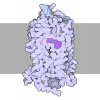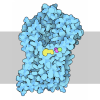[English] 日本語
 Yorodumi
Yorodumi- PDB-8tr7: Cryo-EM structure of the rat P2X7 receptor in complex with the al... -
+ Open data
Open data
- Basic information
Basic information
| Entry | Database: PDB / ID: 8tr7 | |||||||||
|---|---|---|---|---|---|---|---|---|---|---|
| Title | Cryo-EM structure of the rat P2X7 receptor in complex with the allosteric antagonist A839977 | |||||||||
 Components Components | P2X purinoceptor 7 | |||||||||
 Keywords Keywords | MEMBRANE PROTEIN / Ion Channel / Ligand-gate Ion Channel / P2X Receptor / Allosteric Antagonist / High-Affinity Agonist | |||||||||
| Function / homology |  Function and homology information Function and homology informationThe NLRP3 inflammasome / regulation of presynaptic dense core granule exocytosis / Platelet homeostasis / positive regulation of lymphocyte apoptotic process / positive regulation of bleb assembly / NAD transport / phagolysosome assembly / Elevation of cytosolic Ca2+ levels / phospholipid transfer to membrane / positive regulation of cytoskeleton organization ...The NLRP3 inflammasome / regulation of presynaptic dense core granule exocytosis / Platelet homeostasis / positive regulation of lymphocyte apoptotic process / positive regulation of bleb assembly / NAD transport / phagolysosome assembly / Elevation of cytosolic Ca2+ levels / phospholipid transfer to membrane / positive regulation of cytoskeleton organization / purinergic nucleotide receptor activity / extracellularly ATP-gated monoatomic cation channel activity / lymphocyte apoptotic process / purinergic nucleotide receptor signaling pathway / positive regulation of monoatomic ion transmembrane transport / gamma-aminobutyric acid secretion / pore complex assembly / positive regulation of interleukin-1 alpha production / plasma membrane organization / positive regulation of gamma-aminobutyric acid secretion / negative regulation of cell volume / bleb / collagen metabolic process / plasma membrane phospholipid scrambling / ATP export / response to fluid shear stress / T cell apoptotic process / positive regulation of prostaglandin secretion / bleb assembly / mitochondrial depolarization / vesicle budding from membrane / ceramide biosynthetic process / positive regulation of T cell apoptotic process / programmed cell death / prostaglandin secretion / positive regulation of ossification / cellular response to dsRNA / cell volume homeostasis / positive regulation of glutamate secretion / glutamate secretion / negative regulation of bone resorption / skeletal system morphogenesis / phospholipid translocation / positive regulation of macrophage cytokine production / response to ATP / response to zinc ion / positive regulation of mitochondrial depolarization / positive regulation of calcium ion transport into cytosol / T cell homeostasis / synaptic vesicle exocytosis / monoatomic cation transport / membrane depolarization / membrane protein ectodomain proteolysis / : / protein secretion / negative regulation of MAPK cascade / neuronal action potential / positive regulation of bone mineralization / response to electrical stimulus / response to mechanical stimulus / regulation of sodium ion transport / T cell proliferation / homeostasis of number of cells within a tissue / extrinsic apoptotic signaling pathway / release of sequestered calcium ion into cytosol / sensory perception of pain / protein serine/threonine kinase activator activity / reactive oxygen species metabolic process / positive regulation of glycolytic process / positive regulation of interleukin-1 beta production / apoptotic signaling pathway / mitochondrion organization / positive regulation of protein secretion / establishment of localization in cell / response to bacterium / lipopolysaccharide binding / protein catabolic process / neuromuscular junction / terminal bouton / T cell mediated cytotoxicity / cell morphogenesis / : / protein processing / calcium ion transmembrane transport / response to calcium ion / positive regulation of interleukin-6 production / positive regulation of T cell mediated cytotoxicity / calcium ion transport / MAPK cascade / cell-cell junction / nuclear envelope / channel activity / signaling receptor activity / scaffold protein binding / gene expression / response to lipopolysaccharide / positive regulation of MAPK cascade / cell surface receptor signaling pathway / postsynapse / defense response to Gram-positive bacterium Similarity search - Function | |||||||||
| Biological species |  | |||||||||
| Method | ELECTRON MICROSCOPY / single particle reconstruction / cryo EM / Resolution: 2.53 Å | |||||||||
 Authors Authors | Oken, A.C. / Ditter, I.A. / Lisi, N.E. / Krishnamurthy, I. / McCarthy, A.E. / Godsey, M.H. / Mansoor, S.E. | |||||||||
| Funding support |  United States, 2items United States, 2items
| |||||||||
 Citation Citation |  Journal: Sci Adv / Year: 2024 Journal: Sci Adv / Year: 2024Title: P2X receptors exhibit at least three modes of allosteric antagonism. Authors: Adam C Oken / Ismayn A Ditter / Nicolas E Lisi / Ipsita Krishnamurthy / Michael H Godsey / Steven E Mansoor /  Abstract: P2X receptors are trimeric ion channels activated by adenosine triphosphate (ATP) that contribute to pathophysiological processes ranging from asthma to neuropathic pain and neurodegeneration. A ...P2X receptors are trimeric ion channels activated by adenosine triphosphate (ATP) that contribute to pathophysiological processes ranging from asthma to neuropathic pain and neurodegeneration. A number of small-molecule antagonists have been identified for these important pharmaceutical targets. However, the molecular pharmacology of P2X receptors is poorly understood because of the chemically disparate nature of antagonists and their differential actions on the seven constituent subtypes. Here, we report high-resolution cryo-electron microscopy structures of the homomeric rat P2X receptor bound to five previously known small-molecule allosteric antagonists and a sixth antagonist that we identify. Our structural, biophysical, and electrophysiological data define the molecular determinants of allosteric antagonism in this pharmacologically relevant receptor, revealing three distinct classes of antagonists that we call shallow, deep, and starfish. Starfish binders, exemplified by the previously unidentified antagonist methyl blue, represent a unique class of inhibitors with distinct functional properties that could be exploited to develop potent P2X ligands with substantial clinical impact. | |||||||||
| History |
|
- Structure visualization
Structure visualization
| Structure viewer | Molecule:  Molmil Molmil Jmol/JSmol Jmol/JSmol |
|---|
- Downloads & links
Downloads & links
- Download
Download
| PDBx/mmCIF format |  8tr7.cif.gz 8tr7.cif.gz | 572.5 KB | Display |  PDBx/mmCIF format PDBx/mmCIF format |
|---|---|---|---|---|
| PDB format |  pdb8tr7.ent.gz pdb8tr7.ent.gz | 480.4 KB | Display |  PDB format PDB format |
| PDBx/mmJSON format |  8tr7.json.gz 8tr7.json.gz | Tree view |  PDBx/mmJSON format PDBx/mmJSON format | |
| Others |  Other downloads Other downloads |
-Validation report
| Summary document |  8tr7_validation.pdf.gz 8tr7_validation.pdf.gz | 1.6 MB | Display |  wwPDB validaton report wwPDB validaton report |
|---|---|---|---|---|
| Full document |  8tr7_full_validation.pdf.gz 8tr7_full_validation.pdf.gz | 1.6 MB | Display | |
| Data in XML |  8tr7_validation.xml.gz 8tr7_validation.xml.gz | 68.9 KB | Display | |
| Data in CIF |  8tr7_validation.cif.gz 8tr7_validation.cif.gz | 102.7 KB | Display | |
| Arichive directory |  https://data.pdbj.org/pub/pdb/validation_reports/tr/8tr7 https://data.pdbj.org/pub/pdb/validation_reports/tr/8tr7 ftp://data.pdbj.org/pub/pdb/validation_reports/tr/8tr7 ftp://data.pdbj.org/pub/pdb/validation_reports/tr/8tr7 | HTTPS FTP |
-Related structure data
| Related structure data |  41572MC  8tr6C  8tr8C  8traC  8trbC  8trkC M: map data used to model this data C: citing same article ( |
|---|---|
| Similar structure data | Similarity search - Function & homology  F&H Search F&H Search |
- Links
Links
- Assembly
Assembly
| Deposited unit | 
|
|---|---|
| 1 |
|
- Components
Components
-Protein / Sugars , 2 types, 9 molecules ABC

| #1: Protein | Mass: 68472.461 Da / Num. of mol.: 3 Source method: isolated from a genetically manipulated source Source: (gene. exp.)   Homo sapiens (human) / References: UniProt: Q64663 Homo sapiens (human) / References: UniProt: Q64663#5: Sugar | ChemComp-NAG / |
|---|
-Non-polymers , 6 types, 313 molecules 








| #2: Chemical | Mass: 413.260 Da / Num. of mol.: 3 / Source method: obtained synthetically / Formula: C19H14Cl2N6O / Feature type: SUBJECT OF INVESTIGATION #3: Chemical | #4: Chemical | ChemComp-ZN / #6: Chemical | ChemComp-PLM / #7: Chemical | ChemComp-NA / | #8: Water | ChemComp-HOH / | |
|---|
-Details
| Has ligand of interest | Y |
|---|---|
| Has protein modification | Y |
-Experimental details
-Experiment
| Experiment | Method: ELECTRON MICROSCOPY |
|---|---|
| EM experiment | Aggregation state: PARTICLE / 3D reconstruction method: single particle reconstruction |
- Sample preparation
Sample preparation
| Component | Name: Membrane protein / Type: COMPLEX / Entity ID: #1 / Source: RECOMBINANT |
|---|---|
| Source (natural) | Organism:  |
| Source (recombinant) | Organism:  Homo sapiens (human) / Cell: HEK293 GNTI- Homo sapiens (human) / Cell: HEK293 GNTI- |
| Buffer solution | pH: 7 |
| Specimen | Embedding applied: NO / Shadowing applied: NO / Staining applied: NO / Vitrification applied: YES |
| Vitrification | Instrument: FEI VITROBOT MARK IV / Cryogen name: ETHANE |
- Electron microscopy imaging
Electron microscopy imaging
| Experimental equipment |  Model: Titan Krios / Image courtesy: FEI Company |
|---|---|
| Microscopy | Model: FEI TITAN KRIOS |
| Electron gun | Electron source:  FIELD EMISSION GUN / Accelerating voltage: 300 kV / Illumination mode: FLOOD BEAM FIELD EMISSION GUN / Accelerating voltage: 300 kV / Illumination mode: FLOOD BEAM |
| Electron lens | Mode: BRIGHT FIELD / Nominal magnification: 130000 X / Nominal defocus max: 1400 nm / Nominal defocus min: 900 nm / Cs: 2.7 mm / C2 aperture diameter: 50 µm |
| Specimen holder | Specimen holder model: FEI TITAN KRIOS AUTOGRID HOLDER |
| Image recording | Electron dose: 43 e/Å2 / Film or detector model: GATAN K3 (6k x 4k) / Num. of real images: 8127 |
| EM imaging optics | Energyfilter slit width: 20 eV |
- Processing
Processing
| CTF correction | Type: PHASE FLIPPING AND AMPLITUDE CORRECTION | ||||||||||||||||||||||||
|---|---|---|---|---|---|---|---|---|---|---|---|---|---|---|---|---|---|---|---|---|---|---|---|---|---|
| Symmetry | Point symmetry: C3 (3 fold cyclic) | ||||||||||||||||||||||||
| 3D reconstruction | Resolution: 2.53 Å / Resolution method: FSC 0.143 CUT-OFF / Num. of particles: 239914 / Symmetry type: POINT | ||||||||||||||||||||||||
| Refine LS restraints |
|
 Movie
Movie Controller
Controller








 PDBj
PDBj









